Effective fox control programs rely on an integrated and coordinated approach using multiple tools across a broad area. Baiting is the most effective, landscape-scale fox control tool available. It can also provide 24-hour control, as baits sit in the landscape waiting for a fox to pick it up.
At a landscape scale, baiting is a vital knowk-down tools, significantly reduce populations across a wide area with relatively minimal effort in a cost-effective way.
Two toxins are approved for use in fox control in Australia: 1080 (sodium fluoroacetate) and PAPP (para-aminopropiophenone). Training and authorisation to use these toxins is required in accordance with state and territory regulations.
Baits come in a variety of ready made, shelf stable, meat baits or can be produced by injecting the required dose of the toxin into a bait substrait such as boneless red meat, chicken, offal or eggs.
Sodium fluoroacetate is a naturally occurring toxin found in more than 30 species of native Australian plants including Acacia georginae (Georgina gidgee) and Gastrolobium. Many Australian native animals, particularly in the south-west of Western Australia, have developed a tolerance for 1080 because they co-evolved with these plants and therefore the toxin.
The small amount needed to target foxes reduces the risk to off-target native animals. To put native species’ tolerance into perspective, a goanna is more than 250 times more tolerant to 1080 than a fox and a spotted-tailed quoll is 8 times more tolerant than a fox. The way baits are laid, also reduces the risk to many off-target native species.
1080 and PAPP are safe in the environment, as they dilute into harmless compounds in water and are broken down by the bacteria and microorganisms in soil and water.
The risk of secondary poisoning is also very low, as a susceptible animal would need to eat the bait from the stomach or vomit of a poisoned animal — before the toxin degrades.
Baiting methods include ground (usually buried) baiting, aerial baiting and canid pest ejectors (CPEs).
Each approach to baiting has advantages and things to consider.
Using a variety of deployment methods provides flexibility for fox management programs.
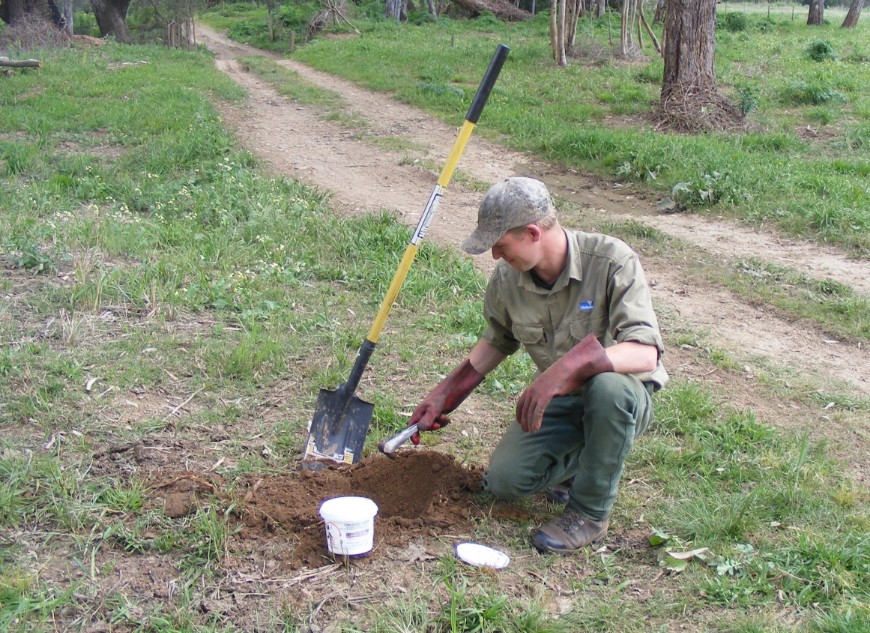
Buried ground baiting is the most common fox baiting method. Photo: National Wild Dog Action Plan.
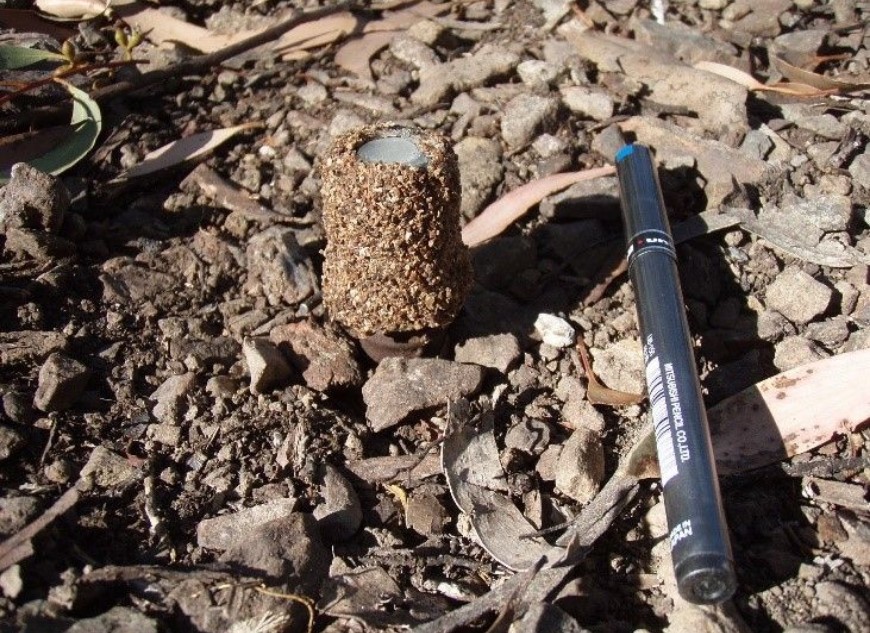
Canid pest ejectors are a more targeted use of 1080 and PAPP for foxes. Photo: National Wild Dog Action Plan.
Advantages of baiting
- Baiting is one of the most effective tools available for feral pest animal control in Australia.
- Baiting is extremely cost effective compared to other control tools.
- Baiting delivers landscape scale population reduction of invasive predators.
- Baiting is easily incorporated into general farm- and pest-management activities.
- The toxin type, bait type, and baiting method (e.g. bait burial and canid pest ejectors design) allow this tool to be relatively species-specific.
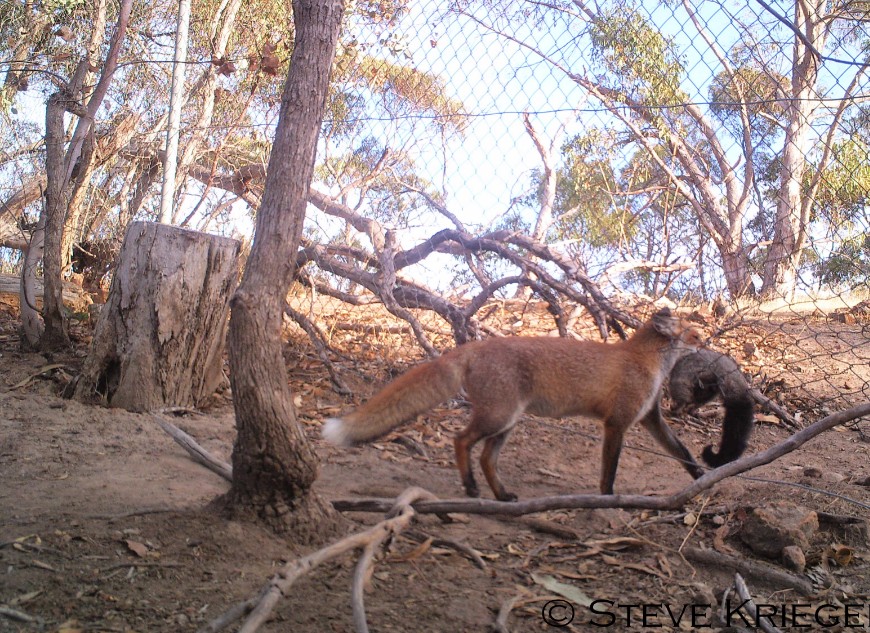
Baiting is the most effective fox management tool to reduce fox impacts on wildlife and livestock. Photo: National Trust of South Australia.
Things to consider before baiting
- Baiting is strictly regulated in Australia. Legislation restricts the use of some baits and methods in some jurisdictions. Training and permits are required in most.
- Time must be factored into your management programs to obtain training, permits and authorisation.
- There is no antidote for 1080, so working dogs and pets can die if they eat a bait. Inform neighbours and display signs where it is used.
- Muzzle working dogs when off the chain and deactivate any deployed canid pest ejectors when working dogs are in the area. Stop pet cats and dogs from roaming.
- Native wildlife have a lower tolerance to PAPP than 1080. Some animals includig goannas, bandicoots and birds such as ducks are likely to eat whole baits. Undertake risk assessments for off-target species.
- Dingoes are susceptible to both PAPP and 1080 baits. In areas where dingoes are being protected, risk assessments and an impact/benefit analysis should be undertaken to reduce the potential for impacts of baiting on dingoes while ensuring the impacts of other introduced predators are reduced.
- It is recommended that PAPP is not used when temperatures are higher than 16oC if goannas are present as they will be more active, and more likely to eat a bait.
- There is an antidote for PAPP (methylene blue); however, it needs to be administered promptly by a veterinarian, which can be difficult in peri-urban and rural areas or if you do not realise that your dog or cat has taken a bait.
- Baits deteriorate and decrease in effectiveness over time. Replacement strategies need to be part of your baiting program.
- Baiting programs can be negatively perceived by some people due to animal welfare concerns. Regulatory guidelines and best practice approaches ensure animal welfare concerns are met while maximising the effectiveness of baiting programs.

Baiting is strictly regulated in Australia with requirements to reduce off-target impacts. Photo: Centre for Invasive Species Solutions.
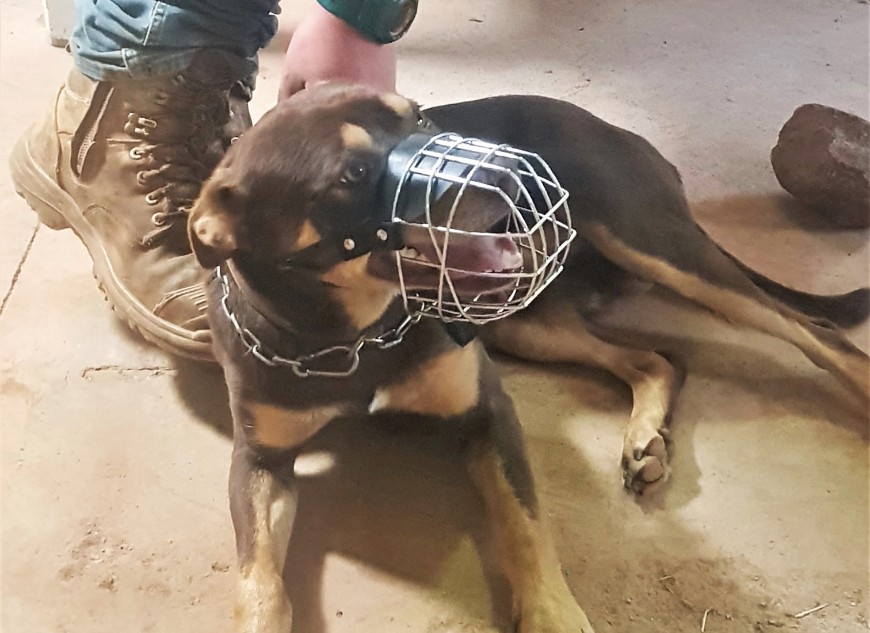
Working dogs can easily be trained to wear a muzzle and can even enjoy it when they associate it with being able to work. Photo: National Wild Dog Action Plan.
Effective use
A targeted, strategic, coordinated, landscape-scale baiting campaign will always produce the best fox management results, especially when coupled with other mop-up control tools. Careful planning, monitoring and adherence to regulatory guidelines and standard operating procedures can increase the effectiveness of baiting programs and minimise risks to off-target animals and the environment.
Baiting is best suited for landscape scale projects. Whether you aerially or ground bait, or both, depends on your terrain, vegetation, land use and budget.
Ground baiting
Ground baiting is the most common fox-baiting method.
Ground baiting involves placing either meat or manufactured baits intended for a fox at intervals on or in the ground at locations where foxes are likely to find them. For example, foxes will travel on the easiest and softest country such as along tracks, roads and sandy country. Physical boundaries like fences, ridgelines and vegetation boundaries can also be good as foxes travel along them looking for a way through and also around water points or food sources.
Most states, and some bait types (Foxecute® and FoxOFF CLB), require fox baits to be buried 8–10 centiemtres deep. Foxes will happily dig for and eat buried food, while native animals generally do not, making buried baiting more species-specific helping avoid off-target poisoning.
Western Australia and Queensland allow baits to be tethered rather than buried, and Western Australia also allows some baits to be hidden under vegetation. A risk assessment can be done in New South Wales to see if it is possible to undertake ground baiting without burial.
Commercially available, ready-to-lay, shelf stable baits, 1080 baits and Foxecute® PAPP baits, are available for purchase. Baits may also be prepared by hand using meat or other attractants that are then injected with toxin.
To be effective and to ensure best practice baiting for fox control you should comply with:
- National Standard Operating Procedure: Ground baiting of foxes with sodium fluoroacetate (1080)
- National Standard Operating Procedure: Baiting of foxes with para-aminopropiophenone (PAPP).
Aerial baiting
Aerial baiting is the most time-, labour-, cost-efficient and scalable method of baiting, but also the most complex. It is limited by factors such as the availability of trained staff and suitable aircraft.
For aerial baiting programs, fixed-wing or rotary-wing aircraft follow a pre-determined flight path with baits deployed at regular intervals to ensure the appropriate rate (number of baits dropped per hectare). Dropped baits form a grid pattern on the ground, making them easier to be detected by foxes and other invasive carnivores.
Meat baits injected with 1080 are the most common bait laid by aerial baiting. Commercially manufactured baits are generally unsuitable for aerial baiting due to their potential to break up after dropping from the aircraft. PAPP baits cannot be used for aerial baiting.
To be effective and to ensure best practice baiting for fox control you should comply with:
Canid pest ejectors
Canid pest ejectors (CPEs) are becoming increasingly known and used in fox baiting programs.
Canid pest ejectors are a mechanical device, staked to the ground, that attracts animals with a bait ‘head’. They cannot be carried away like aerially or ground-laid baits can.
Canid pest ejectors are spring-loaded and deploy a dose of toxin directly into the mouth of a fox or dog when they pull on the bait head with sufficient force (1.9 kg of upward force). The design and required force prevent most native animals from receiving a dose. Both 1080 and PAPP capsuals are available for use in a CPE, but not all states and territories allow the use of PAPP capsules.
The bait head itself does not contain toxin, which is enclosed in a capsule, so CPEs can be left in place for longer than regular baits without the toxin degrading. Units do need to be regularly checked and maintained.
Canid pest ejectors can easily be deactivated to allow farm dogs to safely work in areas where canid pest ejectors are deployed, and then reactivated after working dogs are no longer in the area. Different lures can be purchased or made increasing the chance of attracting a fox to the CPE.
Canid pest ejectors are useful for smaller properties, where you might be concerned about a bait being moved to a neighbour, sites less accesible for regular bait changes, or where you might expect a fox to be moving through the landscape or into a controlled or fox free area.
In this training video Rob Hunt, a Senior Pest Officer with the NSW National Parks and Wildlife Service, describes and demonstrates the Canid Pest Ejector for wild dog and fox control in Australia. Explaining how the CPE works, the associated bait types, how and where to set the CPE, and basic maintenance.
Further information about best practice of CPEs for fox control visit:
- Canid pest ejectors with sodium fluoroacetate (1080).
- NSW Standard Operating Procedure: Candid Pest Ejectors (CPEs) using sodium monoflouroacetate (1080) or para-aminopropiophenone (PAPP)
- The National Standard Operating Procedure: Canid Pest Ejectors (CPEs) using sodium monoflouroacetate (1080) or para-aminopropiophenone (PAPP) is currently being developed.
Protecting domestic and working dogs
Domestic dogs and cats are also susceptible to baits and CPEs used for foxes.
During baiting programs, working dogs and pets should be muzzled or otherwise protected from coming into contact with baits, carcasses or toxic vomit. Dogs can be easily trained to wear a muzzle and even enjoy it when they learn it means they are off to do something they enjoy. Aversion training, to reduce the likelihood of a domestic dog eating a bait, has also been proven to be effective.
If a PAPP bait has been swallowed take your pet directly to a vet to administer an antidote (methylene blue).
If you are using PAPP, let local vets know, so that they will be on alert for any pets that come in with signs and symptoms of poisoning and can administer the methylene blue antidote.
If you suspect your working dog or pet of 1080 poisoning, follow this first aid guide.
For more information look at the National Standard Operating Procedure: The safety and welfare of working dogs used in pest-animal control.

Careful planning, monitoring and adherence to legislation increases effectiveness of baiting programs. Photo: CISS, NFCFMC Program.

Aerial baiting is most effective on a landscape scale, especially where access is difficult. Photo: National Wild Dog Action Plan.
Laws for baiting
Using 1080 and PAPP products for controlling feral animals is strictly regulated in Australia. Training and permits are required for different baiting tools. Appropriate and permissible baiting tools depend on the legislation in your state or territory. Contact them for more information.
PAPP based baits are not recommended, and may not be permitted, in areas with warmer temperatures, like northern Australia.
You must have landholder or land manager permission if baiting on someone else property or public land.
Contact your state or territory them for more information on regulatory requirements for your program.
Banner Photo: CISS, NFCFMC Program.
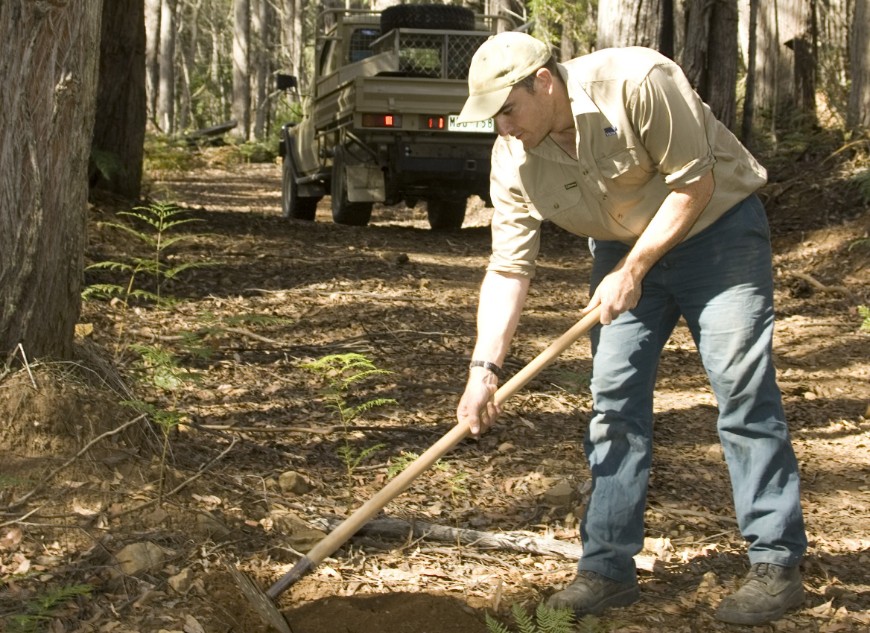
Ground baiting. Photo: National Wild Dog Aaction Plan.
